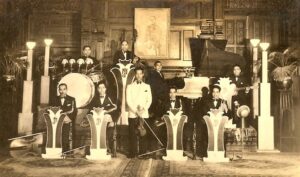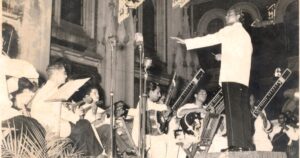Our History
Since its advent, Songs have been an integral part of Indian Cinema, rather a backbone of Indian Story-telling and, more often than not, the main deciding factor in the commercial success of a film. Hence ever since, Music and Musicians have had a vital role in the Film Industry as its main constituent pillars.
Evolution of Music Recording

In the year 1913, great Dadasaheb Falke produced the first Indian feature film ‘Raja Harishchandra‘. In 1931, first Indian Talkie ‘Alam Ara’ was released. There were seven songs in the film.
Between 1913 and 1931, in the silent era, many films were produced. In the absence of any technology to embed sound in the film, an orchestra used to travel with the movie print to cater to the requirement of accompanying music. They would play live background music in real time, whenever and wherever the screening of the film took place! In 1931 the talkie arrived. This entirely changed the scenario as movie-soundtrack came into existence. Now the musicians had to play only once during the time of shooting to get optically recorded in sync with dialogues and picture itself. It could be very intriguing to know how the songs were recorded in those days. There are many fascinating stories about this, told by the musicians who later became our members … How sometimes musicians were made to hide behind the tree, or to sit on it … how sometimes they would have to walk behind the hero or heroine with the instrument tied to their neck … making sure not to be seen in the frame. Sometimes they would sit in a trawler following the moving camera … sometimes would have to wait till midnight for recording to avoid the ambient sound of traffic or that of birds. Gradually, technology advanced and the concept of isolated recording space came into being. In the beginning, there were Soundstages, which would be an allocated space with partial acoustic treatment on a shooting set. The recording set-up would be mobile with machines housed in a van, which would move from one soundstage to another and record the music! Later full-fledged, custom-built recording studios started coming up. Now musicians played once and for all, separately in a recording studio, and the music would later be mixed with dialogues and sound effects of the picture in what was called the “Married Print”!
A Great Fraternity of Cine Musicians Takes Shape

Image Courtesy: Terence Menezes.
In this progressing scenario, the number of movies increased. Consequently, the demand for musicians swelled too. Musicians from different parts of the country started coming to Bombay to try their luck. Glamour of the film industry was a motivating factor too. The musicians from Goa will have to be specially mentioned, who came in large numbers. They specialized in Western Music. They could read, write and play the Staff Notation. Young violinists, who were to become legendary players later, like Joe Menezes, Sebastian D’Souza, Dorado, Jerry Fernandez, C. Franco, Frank Fernand, Michael Martin, B. P. Carvalho, Anthony Gonsalves and many more made Bombay their home.
A new breed of music arrangers like Sebastian, Anthony Gonsalves, Frank Fernand and Chick Chocolate started experimenting in Hindi Film Music. With melody composition, which used to be the mainstay of the song, they started blending western orchestration with harmony, obbligatos, counter melody, etc. Indian classical and folk rhythms were being fused with Latin and Middle-Eastern rhythm styles. Innovative mix of Rock-n-Roll, Jazz etc. was being done with Indian solo instruments!

Image Courtesy: Scroll.in
A parallel line of musicians also got ready by then, who were experts in Indian-style playing; like violinists Narvekar, Gajanan Karnad, Parsekar etc. Name of Ramprasad Sharma, a prominent film musician then, affectionately known as Babaji, needs a very special mention here, as he was the instrumental in creating a battery of musicians whom he taught to become experts in Staff Notation like Goans. He trained musicians from all walks and communities and gradually they became a major force to reckon with in film music industry. Later, some of them became excellent music arrangers too and gave a new character to Film Music, which was not necessarily Western but had equal character of Indian Music too.
The film music kept evolving thus, encompassing all the popular elements of global music scene. Cello players like Albuquerque, Golbert Athaide, Louis Correa; pianists Robert Correa, Lobo Correa, Sunny Castellino, Mike Machado, Rodrigues; mandolin players Parashuram Haldipur, Isaac David, Kishore Desai; flautists Sumantraj, Barve;, accordion and harmonium players Balsara, Goody Sirvai, Babusingh Pawar, Jaykumar Parte; saxophone players Amar Singh, Ramsingh Thethi, C. Franco, Annappa; trumpet players Chick Chocolate, Ramprasad Sharma, Natthuram, George; clarinet players Joe Gomes, Johnny Gomes, Abdulbhai, Master Ibrahim; guitarists Bonny, Castro; sitar players Acharya, Rais Khan, Mayekar; rhythm players Kavas Lord, Leslie Gudinho, Ramakant Mhapsekar, Aachrekar, Abdul Karim, Dattaram, Lalabhau, Sattar, Francis Vaz were some of the prominent names at that time. Unfortunately, none of these legends is amongst us today.
Thus a great fraternity of exemplary musicians and music arrangers coming from all over the country and all communities including Parsis and Anglo-Indians too, was gradually created. This totally changed the face of Hindi film music and imparted a unique color to it.
Idea of an Association is conceived

Image Courtesy: Imprints & Images
But, they were not organized per se. So, producers started taking advantage of the situation. Musicians got paid lesser amounts and that too not on the recording sets. Worse later, they would have to make several rounds of the producer’s offices to collect their wages. Exploitation of musicians was at its peak.
Eventually, the musicians got fed up with this abuse. An incident, where – after a recording of music director O. P. Naiyyar finished – the producer started making excuses for payment, was the last straw. They realized enough was enough! The young and prominent musicians like flautist Sumantraj, mandolin player firebrand leader Parashuram Haldipur, harmonium player Balsara, saxophone player Ramsingh along with Sebastian D’Souza, Joe Menezes, C. Franco and some others took lead and decided to act.
And the CMA is Born
Sumantraj called a meeting of musicians at his home. They decided to form a union. After several meetings with the musicians, the union took shape and was named “CINE MUSICIANS ASSOCIATION”. It was in the year 1952 that the first meeting of the Assocation was held at Jina hall, Grant road. A Managing Committee was formed and Sumantraj was declared the President. He was the top flautist at that time. He played many instruments like flute, kanun, harp, musical saw and the likes. He played for almost all music directors. With his jovial nature and good sense of humor, he was very popular with all.
The committee comprised following members:
| President | Shri Sumant Raj |
| Vice-President | Shri Ramsingh Thethi Shri Joe Menezes |
| Honorary Secretaries | Shri V. Balsara Shri C. Franco |
| Honorary Treasurer | Shri A. B. Albuquerque |
| Committee Members | Shri Isaac David Shri V. S. Rodrigues Shri Bonny D’costa Shri B. P. Carvalho Shri Purushram Shri Golbert Athaide Shri M. Shaffi |

On 30th June 1953, they got the name “Cine musicians Association” registered with the Registrar of Trade Unions under the Indian Trade Union Act, 1926. CMA was born! We still have this seventy-year-old document of registration preserved. Parashuram Haldipur and C. Franco made special efforts to reach out to the musicians and convince them to join the Association. First Annual General Body Meeting of this newborn association was held on 15th February 1954. The constitution of CMA was written, which has always been, and still is the main guiding lantern for the Association. We will always be indebted to the first managing committee for their vision.
As an association, now they could directly negotiate the terms with producers. They devised a grade system depending on the skill and seniority of the musicians and fixed remuneration for each grade, in consultation with the Producers Association IMPAA. Things were getting streamlined but the issue of cash payment on the sets was not fully resolved yet. It was music director O. P. Naiyyer who helped musicians in this matter. He told his producers that he would record their songs only if the producer agrees to pay musicians in cash on the recording set itself. He made producers realize that the musicians were daily wage earners, so they should be paid in cash, and that too immediately after the recording is over. Thus the system of cash-payment-on-the-set started. Hereafter, smooth functioning of CMA began.
The Managing Committees
Since then, each managing committee has tirelessly worked towards the benefit of musicians. If we ever faced any tough situation, which we did at times during our long journey as an association, we sailed through it with the unity of our members and the vision of our office-bearers, which have been our main strength all through. We can never forget the sacrifices made by some of our office bearers and committee members in safeguarding the interest of their members on several occasions. They have always fought fearlessly against any injustice being done to the musicians by music directors or producers even at the risk of being victimized later for their courage! Nothing has ever been able to dampen the spirit of the Cine Musicians Association as a mother body, which cares for and loves all its musician members.
Behind this undying spirit are the words spoken by our first president Shri Sumantraj …
“Never think about what CMA does for you, always think about what you can do for CMA!"
Compiled by
Kapil Harishanker Gupta
Based on the inputs from our senior members
Shri Ashok Jagtap, Shri Pyarelal Sharma, Shri Earnest Menezes,
Shri Kishor Sharma and Shri Neville Franco.
